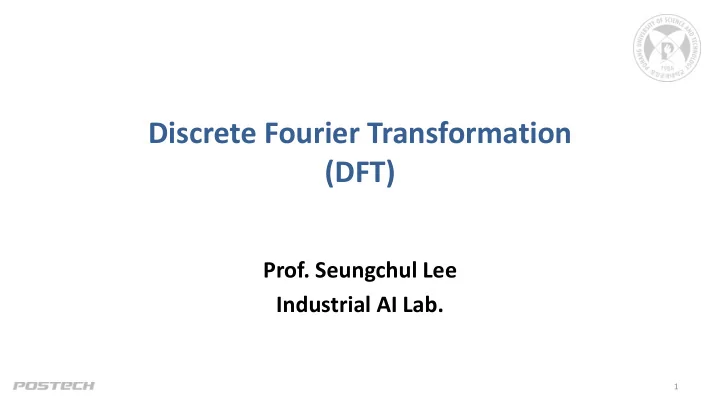

Discrete Fourier Transformation (DFT) Prof. Seungchul Lee Industrial AI Lab. 1
Eigen-Analysis (System or Linear Transformation) 2
Eigenvector and Eigenvalues • Given matrix 𝐵 • Eigenvectors 𝑤 are input signals that emerge at the system output unchanged (except for a scaling by the eigenvalue 𝜇 𝑙 ) and so are somehow “fundamental” to the system • Using this, we can find the following equation • We can change to 3
Eigen-analysis of LTI Systems (Finite-Length Signals) • For length- 𝑂 signals, 𝐼 is an 𝑂 × 𝑂 circulent matrix with entries where ℎ is the impulse response • Goal: calculate the eigenvectors and eigenvalues of 𝐼 – Fact: the eigenvectors of a circulent matrix (LTI system) are the complex harmonic sinusoids – The eigenvalue 𝜇 𝑙 ∈ ℂ corresponding to the sinusoid eigenvectors 𝑡 𝑙 is called the frequency response at frequency 𝑙 since it measures how the system “responds” to 𝑡 𝑙 4
Eigenvector of LTI Systems (Finite-Length Signals) • Prove that – harmonic sinusoids are the eigenvectors of LTI systems simply by computing the circular convolution with input 𝑡 𝑙 and applying the periodicity of the harmonic sinusoids • 𝜇 𝑙 means the number of 𝑡 𝑙 in ℎ[𝑜] ⇒ similarity 5
Eigenvector Matrix of Harmonic Sinusoids 𝑂−1 as columns into an 𝑂 × 𝑂 complex orthonormal basis • Stack 𝑂 normalized harmonic sinusoid 𝑡 𝑙 𝑙=0 matrix 6
Signal Decomposition by Harmonic Sinusoids 7
Basis • A basis {𝑐 𝑙 } for a vector space 𝑊 is a collection of vectors from 𝑊 that linearly independent and span 𝑊 • Basis matrix: stack the basis vectors 𝑐 𝑙 as columns • Using this matrix 𝐶 , we can now write a linear combination of basis elements as the matrix/vector product 8
Orthonormal Basis 𝑂−1 for a vector space 𝑊 • An orthogonal basis 𝑐 𝑙 𝑙=0 – a basis whose elements are mutually orthogonal 𝑂−1 for a vector space 𝑊 • An orthonormal basis 𝑐 𝑙 𝑙=0 – a basis whose elements are mutually orthogonal and normalized in the 2-norm 9
Orthonormal Basis • 𝐶 is a unitary matrix 10
Signal Represented by Orthonormal Basis 𝑂−1 and orthonormal basis matrix 𝐶 • Signal representation by orthonormal basis 𝑐 𝑙 𝑙=0 • Synthesis: build up the signal 𝑦 as a linear combination of the basis elements 𝑐 𝑙 weighted by the weights 𝛽 𝑙 • Analysis: compute the weights 𝛽 𝑙 such that the synthesis produces 𝑦 ; the weights 𝛽 𝑙 measures the similarity between 𝑦 and the basis element 𝑐 𝑙 11
Harmonic Sinusoids are an Orthonormal Basis 𝑂−1 as columns into an 𝑂 × 𝑂 complex orthonormal basis • Stack 𝑂 normalized harmonic sinusoid 𝑡 𝑙 𝑙=0 matrix 12
Discrete Fourier Transform (DFT) 13
DFT and Inverse DFT • Jean Baptiste Joseph Fourier had the radical idea of proposing that all signals could be represented as a linear combination of sinusoids • Analysis (Forward DFT) – The weight 𝑌[𝑙] measures the similarity between 𝑦 and the harmonic sinusoid 𝑡 𝑙 – It finds the “frequency contents” of 𝑦 at frequency 𝑙 14
DFT and Inverse DFT • Jean Baptiste Joseph Fourier had the radical idea of proposing that all signals could be represented as a linear combination of sinusoids • Synthesis (Inverse DFT) – It is returning to time domain – It builds up the signal 𝑦 as a linear combination of 𝑡 𝑙 weighted by the 𝑌[𝑙] 15
Unnormalized DFT • Normalized forward and inverse DFT • Unnormalized forward and inverse DFT 16
Harmonic Sinusoids are an Orthonormal Basis 𝑂−1 as columns into an 𝑂 × 𝑂 complex orthonormal basis • Stack 𝑂 normalized harmonic sinusoid 𝑡 𝑙 𝑙=0 matrix 17
Eigen-decomposition and Diagonalization • 𝐼 is circulent LTI System matrix • 𝑇 is harmonic sinusoid eigenvectors matrix (corresponds to DFT/IDFT) • Λ is eigenvalue diagonal matrix (frequency response) • The eigenvalues are the frequency response (unnormalized DFT of the impulse response) 𝑂−1 on the diagonal of an 𝑂 × 𝑂 matrix • Place the 𝑂 eigenvalues 𝜇 𝑙 𝑙=0 18
Eigen-decomposition and Diagonalization • 𝐼 is circulent LTI System matrix • 𝑇 is harmonic sinusoid eigenvectors matrix (corresponds to DFT/IDFT) • Λ is eigenvalue diagonal matrix (frequency response) 19
Eigen-decomposition and Diagonalization 20
Eigen-decomposition and Diagonalization 21
Eigen-decomposition and Diagonalization 22
Eigen-decomposition and Diagonalization 23
DFT in MATLAB 24
DFT in MATLAB 25
DFT Function 26
Example: DFT 27
Example: DFT 28
Example: DFT 29
Example: DFT 30
Fast Fourier Transform (FFT) • FFT algorithms are so commonly employed to compute DFT that the term 'FFT' is often used to mean 'DFT' – The FFT has been called the "most important computational algorithm of our generation" – It uses the dynamic programming algorithm (or divide and conquer) to efficiently compute DFT. • DFT refers to a mathematical transformation or function, whereas 'FFT' refers to a specific family of algorithms for computing DFTs. – use fft command to compute dft – fft (computationally efficient) • We will use the embedded fft function without going too much into detail. 31
DFT Properties • DFT pair • DFT Frequencies – 𝑌[𝑙] measures the similarity between the time signal 𝑦[𝑜] and the harmonic sinusoid 𝑡 𝑙 [𝑜] 2𝜌 – 𝑌[𝑙] measures the “frequency content” of 𝑦[𝑜] at frequency 𝜕 𝑙 = 𝑂 𝑙 32
DFT Properties • DFT and Circular Shift – No amplitude changed – Phase changed 33
DFT Properties • DFT and Modulation 34
DFT Properties • DFT and Circular Convolution – Circular convolution in the time domain = multiplication in the frequency domain • Proof 35
Filtering in Frequency Domain • Circular convolution in the time domain = multiplication in the frequency domain 36
Example: Low-Pass Filter 37
Example: High-Pass Filter 38
Filtering in Time Domain 39
Filtering in Frequency Domain 40
Recommend
More recommend